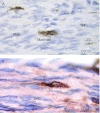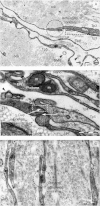Telocytes: ultrastructural, immunohistochemical and electrophysiological characteristics in human myometrium
- PMID: 23404846
- PMCID: PMC3636525
- DOI: 10.1530/REP-12-0369
Telocytes: ultrastructural, immunohistochemical and electrophysiological characteristics in human myometrium
Abstract
Telocytes (TCs) have been described in various organs and species (www.telocytes.com) as cells with telopodes (Tps) - very long cellular extensions with an alternation of thin segments (podomers) and dilated portions (podoms). We examined TCs using electron microscopy (EM), immunohistochemistry (IHC), immunofluorescence (IF), time-lapse videomicroscopy and whole-cell patch voltage clamp. EM showed a three-dimensional network of dichotomous-branching Tps, a labyrinthine system with homocellular and heterocellular junctions. Tps release extracellular vesicles (mean diameter of 160.6±6.9 nm in non-pregnant myometrium and 171.6±4.6 nm in pregnant myometrium), sending macromolecular signals to neighbouring cells. Comparative measurements (non-pregnant and pregnant myometrium) of podomer thickness revealed values of 81.94±1.77 vs 75.53±1.81 nm, while the podoms' diameters were 268.6±8.27 vs 316.38±17.56 nm. IHC as well as IF revealed double c-kit and CD34 positive results. Time-lapse videomicroscopy of cell culture showed dynamic interactions between Tps and myocytes. In non-pregnant myometrium, patch-clamp recordings of TCs revealed a hyperpolarisation-activated chloride inward current with calcium dependence and the absence of L-type calcium channels. TCs seem to have no excitable properties similar to the surrounding smooth muscle cells (SMCs). In conclusion, this study shows the presence of TCs as a distinct cell type in human non-pregnant and pregnant myometrium and describes morphometric differences between the two physiological states. In addition, we provide a preliminary in vitro electrophysiological evaluation of the non-pregnant state, suggesting that TCs could influence timing of the contractile activity of SMCs.
Figures










Similar articles
-
Human myometrium - the ultrastructural 3D network of telocytes.J Cell Mol Med. 2012 Nov;16(11):2844-9. doi: 10.1111/j.1582-4934.2012.01651.x. J Cell Mol Med. 2012. PMID: 23009098 Free PMC article.
-
Effect of Melatonin on Telocytes in the Seminal Vesicle of the Soay Ram: An Immunohistochemical, Ultrastructural and Morphometrical Study.Cells Tissues Organs. 2017;203(1):29-54. doi: 10.1159/000449500. Epub 2016 Nov 2. Cells Tissues Organs. 2017. PMID: 27802428
-
Beta-Estradiol Regulates Voltage-Gated Calcium Channels and Estrogen Receptors in Telocytes from Human Myometrium.Int J Mol Sci. 2018 May 9;19(5):1413. doi: 10.3390/ijms19051413. Int J Mol Sci. 2018. PMID: 29747396 Free PMC article.
-
Telocytes in skeletal, cardiac and smooth muscle interstitium: morphological and functional aspects.Histol Histopathol. 2018 Nov;33(11):1151-1165. doi: 10.14670/HH-11-994. Epub 2018 Apr 25. Histol Histopathol. 2018. PMID: 29693711 Review.
-
Uterine Telocytes: A Review of Current Knowledge.Biol Reprod. 2015 Jul;93(1):10. doi: 10.1095/biolreprod.114.125906. Epub 2015 Feb 18. Biol Reprod. 2015. PMID: 25695721 Review.
Cited by
-
Comparative proteomic analysis of human lung telocytes with fibroblasts.J Cell Mol Med. 2014 Apr;18(4):568-89. doi: 10.1111/jcmm.12290. Epub 2014 Mar 28. J Cell Mol Med. 2014. PMID: 24674459 Free PMC article.
-
Ultrastructural identification of telocytes in the muscularis of chicken ileum.Exp Ther Med. 2015 Dec;10(6):2325-2330. doi: 10.3892/etm.2015.2841. Epub 2015 Oct 30. Exp Ther Med. 2015. PMID: 26668636 Free PMC article.
-
Uterine contractions in rodent models and humans.Acta Physiol (Oxf). 2021 Apr;231(4):e13607. doi: 10.1111/apha.13607. Epub 2021 Jan 7. Acta Physiol (Oxf). 2021. PMID: 33337577 Free PMC article. Review.
-
Comparative Analysis of Telomerase Activity in CD117⁺ CD34⁺ Cardiac Telocytes with Bone Mesenchymal Stem Cells, Cardiac Fibroblasts and Cardiomyocytes.Chin Med J (Engl). 2015 Jul 20;128(14):1942-7. doi: 10.4103/0366-6999.160560. Chin Med J (Engl). 2015. PMID: 26168836 Free PMC article.
-
A Two-Step Immunomagnetic Microbead-Based Method for the Isolation of Human Primary Skin Telocytes/CD34+ Stromal Cells.Int J Mol Sci. 2020 Aug 16;21(16):5877. doi: 10.3390/ijms21165877. Int J Mol Sci. 2020. PMID: 32824287 Free PMC article.
References
Publication types
MeSH terms
LinkOut - more resources
Full Text Sources
Other Literature Sources
Molecular Biology Databases
Miscellaneous

